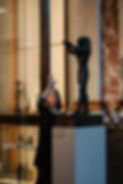Your
Mummy Stories
Share your story, you are part of this conversation!
Since 2017, nearly a hundred individuals from around the globe have shared their encounters with human remains in museums. These are not just stories about ancient bodies; they are stories about curiosity, hesitation, fascination, and sometimes discomfort. They are stories that reveal how people like you feel, how they think, how they confront history and mortality, how they wrestle with ethics in real time. They are stories that remind us that the conversation about human remains in museums is never just academic — it is deeply human.
When I began Mummy Stories, there was no space for the public, people like you, but also academics or curators to share their reflections on Egyptian mummies. Everyone seemed to assume the answer: “Everyone loves mummies!” But that was never the full picture. Some visitors feel wonder, some feel unease; some see history, some see exploitation; some want to connect, some want to question. The multiplicity of reactions, the variety of encounters, became the driving force behind this project.
In that first year, over thirty stories were submitted from France, the United Kingdom, Italy, the Netherlands, Iceland, Canada, the United States, Egypt, China, and Thailand. A child named Bloom wrote about the terror and fascination of seeing a mummy for the first time. Conservators, volunteers, curators, researchers — even visitors who felt “they knew nothing about mummies” — contributed. Every story mattered. Every voice counted.
There are tales inspired by movies, comics, opera, urban legends, and scholarly research alike. Some express awe, some express discomfort, some express disagreement — and that variety is exactly the point. There is no single way to encounter a mummy.
I have watched this collection grow into a living archive of human experience. It is a space where opinions that challenge museums are not only welcomed but celebrated. People who initially hesitated — worried they “knew nothing” — often produced the richest, most surprising reflections. That is because storytelling is not about expertise alone; it is about attention, care, and curiosity. It is about connecting with the past and questioning the present.
Mummy Stories is also a platform for curators, researchers, and emerging voices in the museum world. It is a place to share insights, to test ideas, to experiment with narrative and ethics.
This is an invitation for you to be part of Mummy Stories. Today, your voice, your story, your experience can influence decision-making in museum practices ; it all starts with your own submission of a story to Mummy Stories. Your story can be a single line: “I went to X museum, I saw a mummified body, and this is how I felt about it.” Or it can be a longer reflection, a blog, a university essay, a piece of research you want to share with the public. I also collaborate with universities, where submitting an essay can be part of the curriculum, and we can discuss my visit for a brief introductory talk to spark ideas and guide reflection.

As Mummy Stories continues, the invitation stands wider than ever. Share your encounter. Share your reflections. Share your story, and join the chorus of voices shaping the future of ethical,
inclusive, and deeply human museum practice.




